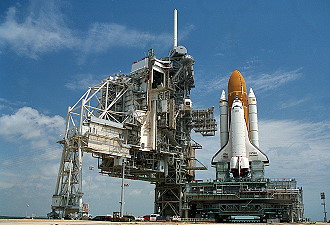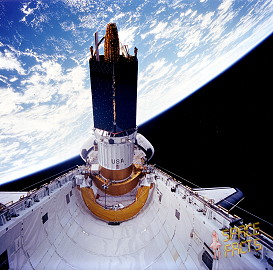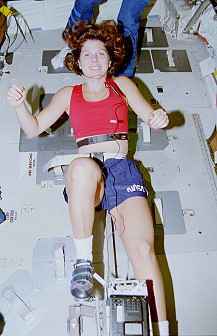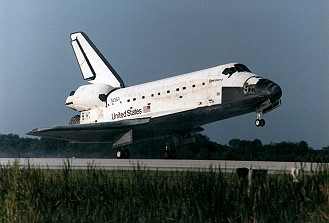Human Orbital Spaceflights
![]()
International Flight No. 177STS-70Discovery (21)70th Space Shuttle missionUSA |
 |
 |
|
Source: www.spacepatches.nl |
||
 |
 |
|
![]()
Launch, orbit and landing data
walkout photo |
 |
||||||||||||||||||||||||||||
alternative crew photo |
Crew
| No. | Surname | Given names | Position | Flight No. | Duration | Orbits | |
| 1 | Henricks | Terence Thomas "Tom" | CDR | 3 | 8d 22h 20m 04s | 142 | |
| 2 | Kregel | Kevin Richard | PLT, IV-1 | 1 | 8d 22h 20m 04s | 142 | |
| 3 | Thomas | Donald Alan | MS-1, EV-2 | 2 | 8d 22h 20m 04s | 142 | |
| 4 | Currie | Nancy Jane Sherlock | MS-2, FE | 2 | 8d 22h 20m 04s | 142 | |
| 5 | Weber | Mary Ellen | MS-3, EV-1 | 1 | 8d 22h 20m 04s | 142 |
Crew seating arrangement
|
 |
|
||||||||||||||||||||||||
Hardware
| Orbiter : | OV-103 (21.) |
| SSME (1 / 2 / 3): | 2036-1 (1.) / 2019 (15.) / 2017 (12.) |
| SRB: | BI-073 / RSRM 44 |
| ET: | ET-71 (LWT-64) |
| OMS Pod: | Left Pod 01 (24.) / Right Pod 03 (22.) |
| FWD RCS Pod: | FRC 3 (21.) |
| RMS: | - |
| EMU: | EMU No. 2039 (PLSS No. 1013) / EMU No. 2040 (PLSS No. 1014) |
Flight
|
Launch from Cape Canaveral (KSC) and
landing on Cape Canaveral (KSC), Runway 33. STS-70 had originally moved ahead of STS-71 because of a delay in the launch of the Russian Spektr laboratory module to the Russian space station Mir. However, on May 31, 1995 shuttle managers assessed damage to the External Tank of STS-70 caused by nesting Flicker Woodpeckers. The damage consisted of about 71 holes (ranging in size from 4 inches (10 centimeters) in diameter to ½ inch (1.3 centimeter) in diameter) in the ETs thermal protection foam insulation. Technicians installed safeguards against additional damage. On June 02, 1995, NASA managers decided to delay the launch of Discovery in order to make repairs to the insulation, and STS-71 was moved ahead of STS-70. Discovery was rolled back to the VAB on June 08, 1995, and was returned to the pad on June 15, 1995. STS-70 marked the maiden flight of the new Block 1 orbiter main engine. Engine number 2036 featured the new high-pressure liquid oxygen turbo-pump, a two-duct power-head, baffleless main injector, single-coil heat exchanger and start sequence modifications. The Block I engine flew in the number one position on Discovery. The other two engines were of the existing Phase II design. Deploying of communications-satellite TDRS-G with the two-stage Inertial Upper Stage (IUS) solid rocket was the primary mission goal. The TDRS system is a space-based network that provides communications, tracking, telemetry, data acquisition and command services essential to the Space Shuttle and other low-Earth orbital spacecraft such as the Hubble Space Telescope (HST), the Compton Gamma Ray Observatory (GRO), the Upper Atmosphere Research Satellite (UARS), Cosmic Background Explorer (COBE), Extreme Ultraviolet Explorer (EUVE), TOPEX-Poseidon, Landsat and many more. Secondary objectives of the mission were to fulfill the requirements of the Physiological and Anatomical Rodent Experiment / National Institutes of Health-Rodents (PARE/NIH-R); Bioreactor Demonstration System (BDS), Commercial Protein Crystal Growth (CPCG); Space Tissue Loss/National Institutes of Health-Cells (STL/NIH-C); Biological Research in Canisters (BRIC); Shuttle Amateur Radio Experiment-II (SAREX-II), Visual Function Tester-4 (VFT-4); Hand-Held, Earth Oriented, Real-Time, Cooperative, User-Friendly, Location-Targeting and Environmental System (HERCULES); Microcapsules in Space-B (MIS-B); Windows Experiment (WINDEX); Radiation Monitoring Equipment-III (RME-III); and the Military Applications of Ship Tracks (MAST). NASA's latest Tracking and Data Relay Satellite, TDRS-G, was scheduled for launch on board Discovery. TDRS-G is the seventh and final in the first series of communications spacecraft that make up the TDRSS. Although TDRS-G was stored on orbit and not used immediately, it was being launched now to take advantage of the experienced crew for the critical launch and deployment sequence. In addition, on-orbit storage was less costly than ground storage and extended crew retention. Once it is on orbit, the TDRS-G designation was changed to TDRS-7. The TDRS' were composed of three distinct modules: An equipment module, a communications payload module and an antenna module. The modular design reduced the cost of individual design and construction efforts that, in turn, lower the cost of each satellite. The equipment module housed the subsystems that operate the satellite is located in the lower hexagon portion of the main body of the spacecraft. The attitude control subsystem stabilized the satellite to provide accurate antenna pointing and proper orientation of the solar panels to the Sun. The electrical power subsystems consisted of two solar panels that provided a ten-year power supply of approximately 1,700 watts. The thermal control subsystem consisted of surface coatings and controlled electric heaters. The payload module, located on the upper hexagon portion of the main body of the spacecraft, was composed of the electronic equipment required to provide communications between the user spacecraft and the ground. The receivers and transmitters for single access services were mounted in compartments on the back of the SA antennas. The antenna module was composed of five antenna systems: two SA, the MA arrays, STGL, and the S-band omni for satellite health and housekeeping. The Inertial Upper Stage (IUS) was used on Space Shuttle mission STS-70 to boost NASA's TDRS-G Tracking and Data Relay Satellite from low-Earth orbit to geosynchronous orbit, some 22,300 statute miles (35,000 kilometers) from Earth. The IUS was a two-stage, solid rocket propelled, three-axis stabilized vehicle for placing spacecraft in a high-Earth orbit or on an escape trajectory for an interplanetary mission. The IUS was 17 feet (5.18 meters) long and 9.25 feet (2.8 meters) in diameter, with an overall weight of approximately 32,500 pounds (14,742 kilograms). The IUS consisted of a first stage comprised of a large solid rocket motor containing 21,400 pounds (9,707 kilograms) of propellant and generating approximately 42,000 pounds (188,496 Newtons) of thrust and an interstage. The second stage consisted of a solid rocket motor with 6,000 pounds (2,722 kilograms) of propellant generating approximately 18,000 pounds (80,784 Newtons) of thrust, and an equipment support section. TDRS-1 was launched in April 1983, on board Space Shuttle Challenger (STS-6), and the second TDRS was lost in the Challenger accident in January 1986. TDRS-3 was launched on board Space Shuttle Discovery (STS-26) in September 1988, and TDRS-4 was launched on board Discovery (STS-29) in March 1989. TDRS-5 was launched on board Space Shuttle Atlantis (STS-43) in August 1991. TDRS-6 was launched on board Space Shuttle Endeavour (STS-54) in January 1993. The five orbiting TDRS spacecraft were all functioning, but only three (TDRS-4, TDRS-5, and TDRS-6) were fully operational. Because of the flexible capability of the TDRSS, following the successful launch and checkout of TDRS-G, the TDRSS constellation will be reconfigured. After the orbiter payload bay doors are opened in orbit, the orbiter maintained a preselected attitude to keep the payload within thermal requirements and constraints. On-orbit predeployment checkout began, followed by an IUS command link check and spacecraft communications command check. Orbiter trim maneuvers normally were performed at this time. Forward payload restraints were released and the aft frame of the airborne support equipment tilt the IUS/TDRS to an angle of 29 degrees from the payload bay. This extended the TDRS into space just outside the orbiter payload bay, allowing direct communication with Earth during systems checkout. The orbiter then was maneuvered to the deployment attitude. Prior to deployment, the spacecraft electrical power source was switched from orbiter power to IUS internal power by the orbiter flight crew. After verifying that the spacecraft is on IUS internal power and that all IUS/TDRS predeployment operations have been successfully completed, a "go/no-go" decision for IUS/TDRS deployment was sent to the crew. When the orbiter flight crew was given a "go" decision, they activated the pyrotechnic devices that disconnected the IUS/TDRS umbilical cables. The crew commanded the electromechanical tilt actuator to raise the tilt table to a 58-degree deployment position. During deployment, the orbiter's thrusters were inhibited and a pyrotechnic separation device initiated to physically separate the IUS/TDRS spacecraft combination from the tilt table and orbiter. Compressed springs provided the force to push the IUS/TDRS from the orbiter payload bay at approximately 4.2 inches (0.10 meters) per second. Approximately 19 minutes after IUS/TDRS deployment, the orbiter's engines were ignited by Terence Henricks to move the orbiter away from the IUS/TDRS. At approximately 45 minutes after deployment from the orbiter, the pyrotechnic inhibits for the solid rocket motor were removed. The belly of the orbiter was oriented towards the IUS/TDRS combination to protect the orbiter windows from the IUS's plume. The Bioreactor Demonstration System was designed to use ground-based and space-bioreactor systems to grow individual cells into organized tissue that is morphologically and functionally similar to the original tissue or organ. The BDS was composed of a device developed at the Johnson Space Center that used a rotating cylinder to suspend cells and tissues in a growth medium, simulating some aspects of microgravity. The system, which was already used extensively in ground-based research, also provided for gas and nutrient exchange. The purpose of the flight experiment was to demonstrate the performance of the bioreactor in actual microgravity. As such, the primary goal was to assess the fluid dynamic characteristics of the bioreactor in microgravity. Research on plant growth and development, as well as research on the hormone system of insects, was an important part of the scientific mission of STS-70. Biological Research in Canisters (BRIC) experiments, designed to examine the effects of microgravity on a wide range of physiological processes in plants, insects, and small invertebrate animals, were part of the Small Payloads Program. Research in the "quick turnaround" (on average one year or less) BRIC program had provided basic scientific information on a range of important topics, from plant metabolism affecting food crops to information on the processes of insect development and pest control. Previous BRIC experiments had focused on starch metabolism in plant seedlings (BRIC-1 & 3), on development in plant tissue culture (BRIC-2), and on ways that hormones affect the development of gypsy moths from worm-like juveniles to winged adults (BRIC-1). BRIC payloads were flown in canisters located in lockers on the Shuttle's middeck. These canisters were simple carriers for small biological payloads and afford the investigator the opportunity to expose their samples to a microgravity environment for extended periods of time. National Institutes Of Health-R-2: This project emphasized features of the rat's behavior and physiology that are known to contribute to successful pregnancy, labor, delivery and the onset of postnatal care - especially lactation. Lacking the challenge of working against gravity and disruption of specific behaviors, such as self-grooming, may compromise the female's ability to give birth and provide sufficient milk. Development of vestibular (balance) function in all species begins well before birth. The use of pregnant animals exposed to microgravity will eliminate the effects of gravity from direct input during the development of this system. Examination of the behavior of the offspring after birth was expected to provide information about the earliest development of the vestibular system under gravity as compared to microgravity circumstances. The Commercial Protein Crystal Growth (CPCG) experiment aboard STS-70 formed a bridge between NASA and private industry by developing methods for the crystallization of macromolecules in microgravity. These crystals are used to determine the three-dimensional structure of the molecules by X-Ray crystallography. The structural information not only provides a greater understanding of the functions of macromolecules in living organisms, but it also provides scientific insight into the development of new drugs. The Space Tissue Loss-B (STL-B) experiment was a collaborative research project between Walter Reed Army Institute of Research, Washington, DC, and the NASA Life & Microgravity Sciences and Applications Div., Washington DC. The researchers were investigating the effects of microgravity on embryogenesis. Their analysis is centered on the evaluation of a very well described and understood biology model, the Medaka fish egg. The study focuses on evaluating the micro-gravity effect at the molecular level. Of particular interest was the digital image capture of the (gastrolation) development phase via the STL-B on board video microscope and telemetry to the investigators on the ground. This follow-up experiment should help validate previous STS-59 findings as well as provide additional definition to the model for future space biology experimentation. Hand-Held, Earth Oriented, Real-Time, Cooperative, User-Friendly, Location-Targeting and Environmental System (HERCULES-B) was the third generation of a space-based geolocating system. For this configuration, a XYBION multispectral video camera was integrated with the HERCULES geolocation hardware. The second generation, HERCULES-A, used NASA's Electronic Still Camera (ESC) and was flown twice (STS-53 and STS-56). HERCULES-B allowed the system to respond to requirements that exploit multispectral techniques. The geolocation part of the system, built by the Naval Research Laboratory, calculated and tagged every frame of video with latitude and longitude with an accuracy of three nautical miles. The multispectral video camera was a high resolution (38-line pairs/mm) XYBION IMC-301 image intensifying camera. The XYBION was integrated by the Night Vision and Electronic Sensors Directorate. This camera allowed multispectral imagery at 15-meter Ground Sampling Distance (GSD) from the Shuttle in the 500 - 900 nanometer spectral region. The camera used filter wheels that rotate in the optical path at 300 rpm. Several filter wheels (each with six filters), suggested by the Environmental Research Institute of Michigan and the Office of Naval Research, was provided to the crew to be changed during the mission. The camera also had a 'panchromatic mode' that allowed high shutter speed imagery to be obtained. In this mode, the high shutter speeds (<100 microseconds) allowed the effects of Orbiter and operator motion to be decreased. With the longest focal length lens (1,800 mm), GSDs of three meters were anticipated based on laboratory and field measurements. Various focal length lenses (320-1830 mm) were used in panchromatic mode which allowed a wide variety of fields of view and GSDs. Microencapsulation in Space (MIS) made its second space flight aboard the Space Shuttle Discovery. The purpose of this project was to produce a novel pharmaceutical (microencapsulated antibiotic) in weightless conditions using equipment that has been improved since the first MIS flight in 1992 (STS-53). Microencapsulated antibiotics, which are capable of providing precise and predictable sustained drug release rates, control wound infections more effectively than systemically administered antibiotics and do so in vivo after a single application to infected wounds. The microencapsulated formulations provide high antibiotic concentrations in the wound site over a prolonged period of time, during which the polymeric carrier biodegrades into carbon dioxide in water. The end result is that all microorganisms in the wound are killed by the antibiotic, and the drug carrier (polymer) dissolves in the body leaving no residue. MSX was a Department of Defense program, designed to support the development of surveillance capabilities of ballistic missiles during the midcourse of their flight. The principal instrument of the program was a satellite in a 99-degree inclination, 898-kilometer altitude polar orbit. The imaging and spectrographic sensors carried by the MSX satellite covered a broad range of spectral regions from the far ultraviolet to the long wave infrared. The MSX Shuttle experiments are flown under the direction of the Defense Department's Space Test Program and involved using the MSX satellite to observe the plumes from Shuttle engine burns and the Shuttle body, representative of a resident space object (RSO), against Earth and space backgrounds. The objective of Military Applications of Ship Tracks (MAST) was to determine how pollutants generated by ships modify the reflective properties of clouds. Ship tracks are observed in satellite imagery as long, narrow, curvilinear cloud features that have greater brightness than the surrounding clouds. The STS-70 crew photographed ship tracks using large format, handheld cameras. These high-resolution photographs provided insight into the processes of ship track production on a global scale. MAST will help in understanding the effects of man-made aerosols on clouds and the resulting impact on the climate system. Radiation Monitoring Equipment-III (RME-III) was an instrument which measured the exposure to ionizing radiation on the Space Shuttle. It displayed the dose rate and total accumulated radiation dose to the operator, while simultaneously registering the number of radiation interactions and dose accumulated at ten second intervals. This data was stored in RME-III's memory module(s), for follow-up analysis upon return to Earth. The radiation detector used in the instrument was a spatial ionization chamber called a tissue equivalent proportional counter (TEPC) which effectively simulated a target size of a few microns of tissue, the dimensions of a typical human cell. For this reason, TEPC-based instruments such as the RME-III are called micro-dosimeter instruments. WINDEX recorded the dynamics of thruster plumes, Shuttle glow, water dumps, atmospheric nightglow, aurora, and flash evaporator system (FES) releases. Thruster plumes provide the largest perturbations on the LEO environment. Thruster firings can enhance the local densities of gases by several orders of magnitude and introduce numerous non- natural elements. These non-natural elements react with the atmosphere or with the spacecraft systems in the plume cloud. WINDEX would like to record the high speed (< ¼ sec) phenomena associated with the start-up and shut-down transients of the thruster as well as observe how these transients affect the Shuttle glow. Shuttle glow can be an indicator of the flow field around the Shuttle. Measurements of the Shuttle glow will help us understand the chemistry around the Shuttle and obtain a measure of the optical contamination of LEO based sensors. Low-light level spectrally resolved images will provide this information. Water dumps, FES releases, and fuel cell purges also are a major contributor to the non-natural environment around a LEO satellite. WINDEX looked at water dumps to identify particle size and freezing dynamics of liquid water releases in the LEO environment. In order to separate the optical emissions of the near-field glow or plume data from the natural background, WINDEX must obtain atmospheric nightglow information. WINDEX will accomplish this by obtaining spectrally resolved images of limb and nadir night glow. This data will identify the dynamics of the middle and upper atmosphere (50 - 300 km altitude). Information on the aurora will also help define the natural background environment of LEO platforms. VFT-4 gave researchers a chance to get first-hand information and test those ideas. One theory is that the eye is like a water balloon. Rest it on a table and it gets longer as it flattens out (which is the normal condition on Earth). Put that balloon in space and it shortens, becoming more round. The eye could do the same thing and when it shortens it becomes far- sighted, causing more difficulty seeing objects up close. In addition to taking pre-and post-flight measurements of two astronauts' eyes using the Vision Function Tester, the participating astronauts used the instrument daily throughout the Shuttle flight. The information gathered during these 30-minute sessions will also help scientists evaluate how quickly the eye adjusts in space and how it is affected over time. As part of the Shuttle Amateur Radio Experiment (SAREX) students in the United States and other countries had a chance to speak via amateur radio with astronauts aboard the Space Shuttle Endeavour during STS-70. Ground-based amateur radio operators ("hams") were able to contact the Shuttle through automated computer-to-computer amateur (packet) radio links. There also were voice contacts with the general ham community as time permitted. Space Shuttle Mission Specialist Donald Thomas (call sign KC5FVF) talked with students in 10 schools in the U.S. and Argentina using "ham radio". A Shuttle window right of the pilot was damaged by a micrometeorite. Landing opportunities at the Kennedy Space Center at 11:54 UTC and 13:31 UTC July 21, 1995 were waved off due to a buildup of ground fog over the Shuttle Landing Facility. Flight Director Rich Jackson directed the five STS-70 astronauts to remain aloft for another day after poor visibility prevented Discovery's homecoming on the two consecutive landing opportunities. Discovery's astronauts were informed that their landing had been waved off for the day at 12:10 UTC after astronaut Stephen Oswald, flying weather reconnaissance in a Shuttle Training Aircraft over the landing strip, reported that he could not see the 3-mile-long (4.8 km) runway from his vantage point. An earlier KSC landing opportunity on July 22, 1995 at 10:26 UTC was waved off due to marginal yet improving weather conditions at KSC. |
Photos / Graphics
 |
 |
 |
 |
 |
 |
 |
 |
 |
 |
 |
 |
 |
 |
 |
| © |  |
Last update on March 27, 2020.  |
 |